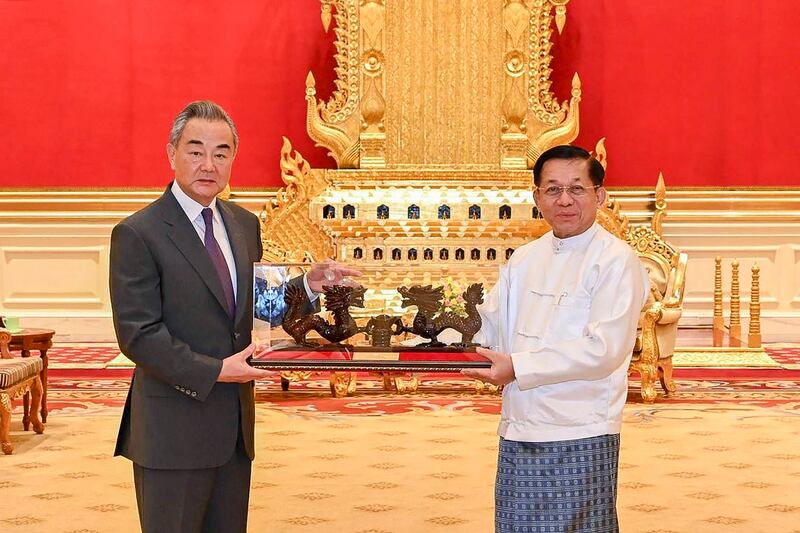Rumors of a putsch swirled around Myanmar last week ahead of Chinese Prime Minister Wang Yi's visit to Naypyidaw where he obliquely rebuked junta chief Senior Gen.l Min Aung Hlaing. Given the scale of recent military losses there were reasons for both.
The opposition’s military gains have fundamentally transformed the battlescape and it is hard to see how the military can recover.
Since the ethnic army offensive known as Operation 1027 began in late 2023, opposition forces have captured over 2,000 military positions. The Arakan Army controls almost the entire northern half of Rakhine, and is rapidly pushing south, meeting little resistance.
The Kachin Independence Army controls every border crossing to China, and it is now on the outskirts of Myitkyina and Bhamo. The Ta’ang National Liberation Army and the Myanmar National Defense Alliance Army control much of northern Shan state.
One conflict monitoring group estimates that there have been 6,000 army casualties since Operation 1027 began. Hastily recruited and poorly trained conscripts are now at the front lines.
The military mustered 5,000 troops for the defense of Lashio and, even with air support, were outmanned and overpowered. When Lashio fell, nearly 5,000 troops and their families surrendered.
The shadow National Unity Government, or NUG, Defense Minister Ye Mon, recently asserted that 75 of 252, or 30%, of the country’s towns and cities are completely liberated, while 74 are being contested. Only one-third of the cities and towns are under full military control, though they are the largest population centers.
Since Operation 1027 began, the military has been unable to recapture almost any territory, and where it has, it's been through sheer scorched earth tactics, intended to depopulate communities.
Unappreciated role of PDFs
While so much attention has been focused on the gains of the ethnic resistance organizations, or EROs, not enough attention has been paid to the NUG’s People’s Defense Forces, also known as PDFs.
When the PDFs were first established in 2021, they were largely written off as nothing more than canon fodder. Filled with urban youths who fled the junta, they had few arms.
Take a moment to read more
[ Myanmar’s old army leader calls on China to help restore stabilityOpens in new window ]
[ China top diplomat meets Myanmar leader, junta denies coup rumorsOpens in new window ]
[ Top Myanmar army officers seized by insurgents in Shan state, junta saysOpens in new window ]
[ China’s frustration with the Myanmar junta’s incompetence is mountingOpens in new window ]
Groups like the Karen National Liberation Army and the Ta’ang National Liberation Army provided training and a limited supply of arms and ammunition. By 2022 and 2023, the NUG was able to supply the PDFs with a steady stream of funding, which allowed them to begin to purchase weapons on the black market.
But most of the weapons they obtained were captured on the battlefield. Each successive victory gave them the arms and munitions that laid the foundation for future victories.
The PDFs have been disciplined and highly motivated, committed to the political goals of a federal democracy.
Taking advantage of their tech savvy youth, they have also been technically proficient and innovative, quickly utilizing commercial drones, long before any ERO or the military did.
PDFs have played an under-appreciated role in all of the Operation 1027 battles. They fought alongside the Karen Nationalities Defence Force in Kayah state, the Ta’ang National Liberation Army, and Kachin Independence Army.
The NUG was smart enough to put many of their units under the operational command of the various EROs, which had more battlefield experience.
But the PDFs have demonstrated exceptional battlefield experience in the past two years. In some regions, they are doing the lion’s share of the fighting.
Operation Shan-Man
The Mandalay PDF has built on the success of the Ta’ang National Liberation Army in northern Shan state.
It moved out of the hills to the east of the Irrawaddy River, capturing the town of Singu, a mere 50 km (30 miles) north of Mandalay.
This allowed them to block the movement of troops and supplies up Route 311 to the southern Kachin city of Bhamo, evidence of close tactical coordination between the NUG and the EROs.
The Mandalay PDF continues to stage attacks along that road. Last week they captured Takaung, which is the symbolic center of the Burmese empire, and Thabeikkyin township, situated between Singu and Takaung. In addition, they have taken nine army camps.

Control of these towns not only gives them control of the highway, but also, should they be able to acquire heavier weaponry, control of the movement of troops and supplies along the Irrawaddy River.
PDFs have increased sporadic, though not sustained, attacks on the outskirts of Mandalay, the country’s second largest city.
Roughly 100 km (60 miles) to the city’s southwest, PDFs have been engaged in fighting across Myingyan township. Four separate PDFs converged on Taungtha township.
Other PDFs moved on the town of Natogyi. The government quickly responded, deploying 200 reinforcements to retake the town, where there is a pumping and off-take station for China’s parallel oil and gas pipeline from Kyaukphyu in Rakhine state to Kunming, across the border in Yunnan province. PDFs had briefly held the guard stations at the facility.
The escalation of fighting in the region prompted the Singapore-listed Sembcorp to indefinitely suspend operations at its US$300 million, 225-megawatt gas-fired power plant, which was opened in 2019. For a country already suffering acute power shortages, this is another blow for the faltering junta.
From four cuts to depopulation
While the NUG and their PDFs are quick to capitalize on their victories, releasing videos of townspeople warmly welcoming opposition forces, there are costs entailed with liberation.
When Operation 1027 began, the Kachin Independence Army and PDFs took over Kawlin township, in the heart of Sagaing region’s dry zone. This prompted a brutal counterattack. For nearly two weeks the town was shelled and bombed.
PDF-initiated attacks have also intensified in recent weeks in southern Sagaing, prompting fierce reprisals, mass arson attacks, and artillery strikes. Likewise, the military has lashed out in Shan state, indiscriminately bombing civilians in towns captured by the armed opposition.
A desperate regime seems to be adapting its already brutal counter-insurgency doctrine known as the “Four Cuts,” which is designed to terrorize the population into submission, to a Russian style campaign of depopulating territories.
Signs of strain
Min Aung Hlaing met with China’s Wang Yi, on Aug. 15, dispelling claims that he had been ousted by his peers.
But given the battlefield failures and his penchant for scapegoating, one certainly understands why there is growing dissatisfaction and unease.

Min Aung Hlaing has been rotating generals at breakneck speed. Of the 14 regional military commands, seven have been assigned new commanders in 2024 alone. The Northeast Command has had three commanders in the past two months alone.
Only one of the 14 regional military commanders has been in place since January 2022. The remainder were replaced between April and August 2023. Of the six Bureau of Special Operation commanders that oversee the regional military commands, four have been replaced since April 2023. This month Lt. General Ni Lin Aung was assigned to oversee the four regional military commands in Shan state.
There are reports that the State Administrative Council, as the junta is formally known, has assigned its second ranking official, General Soe Win, to personally lead counter-offensive operations.
The junta has detained several commanders and their deputies from the Triangle Region, Northeast, and Central Region commands.
The costs of failure are high as the regime searches for people to blame. But more failure is likely, as the flailing junta is confronted by a surging opposition, and the financial and logistical realities that make any counter-offensive impossible.
Zachary Abuza is a professor at the National War College in Washington and an adjunct at Georgetown University. The views expressed here are his own and do not reflect the position of the U.S. Department of Defense, the National War College, Georgetown University or Radio Free Asia.
